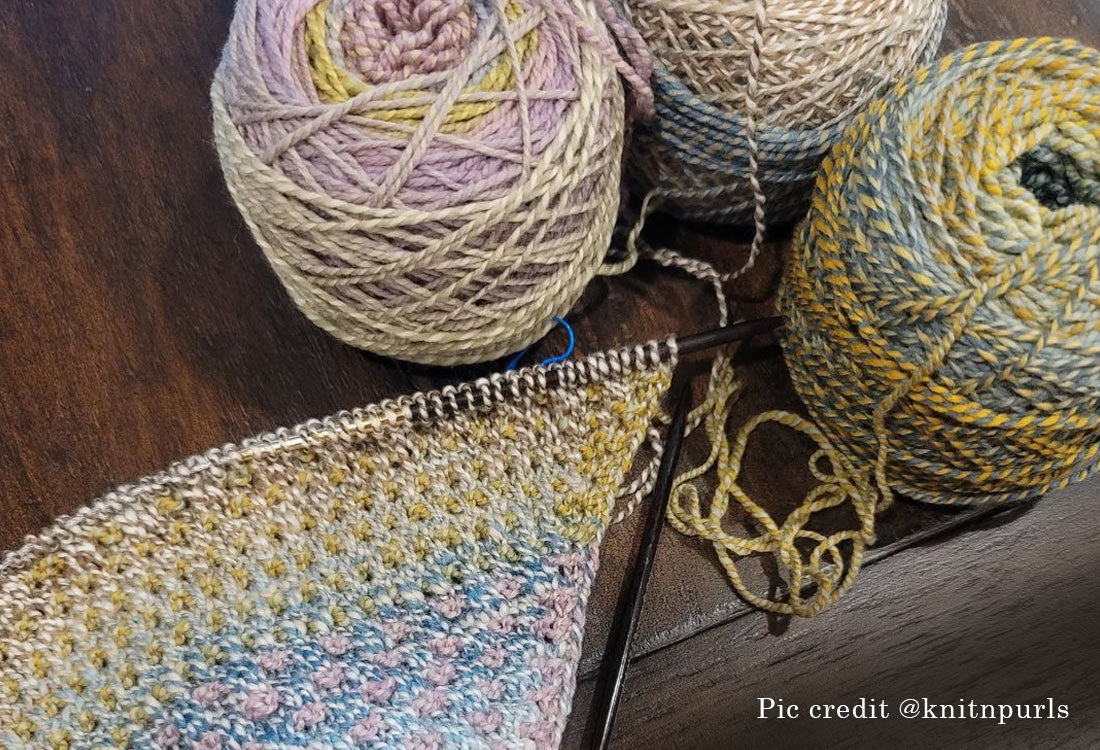
Once you’ve learned to knit and purl, you would be getting straight to cast stitches on your knitting needles and make some projects. Projects like a dishcloth or a scarf (flat and rectangle) can be worked with these steps, but for projects such as a cardigan or sweater (made in the round or even flat), there is a need to know knitting techniques for increasing and decreasing stitches. Learning to increase and decrease will instantly elevate your knitting skills. They are techniques to shape your projects. Increase simply means to increase stitches than the previous rows or rounds.
In this blog, we’ll discuss techniques for knitting to increase stitches. There are many ways to increase stitches in your knitting. Each method depends on your project and your convenience. Even if you are adept at knitting increases with one method, it is always worth exploring different methods. In this blog post, we’ll walk you through the different ways of knitting increases.
You can practice these knitting techniques directly on your project or make a gauge swatch and then try each method and see what works best for you. The increased techniques work whether you are knitting back and forth with single-pointed knitting needles or circulars. The same methods also work when you are knitting in the round with double-pointed needles, fixed circulars, or interchangeable knitting needles ones. A knitting pattern mostly instructs the increase technique with an abbreviation rather than explaining the steps. Knowing how to increase it is a knitting skill that make the knitter a seasoned pro.
What is Increasing?
Increasing and decreasing refers to the methods to change the stitch counts of a particular project from a previous row or round. In other words, if you cast on and knit 50 stitches, an “increase” will take you to numbers more than 50 in the consecutive rows and rounds and a “decrease” will take the count lesser than 50.
There are different reasons to increase stitches and different techniques for each of them.
Right-Leaning vs. Left-Leaning Increases
All increased stitches will have a lean to them. The term "lean" in knitting simply refers to the side of the original stitch where the increased stitch will appear. Similarly, a decrease will also have a lean. The difference in the right or left lean is in the way the stitches lie in the way you knit that extra loop. If you knit through the back loop you create a left-leaning increase, and if you knit through the front part of the loop, you create a right-leaning increase. The lean also depends on the stitch increase technique.
How to Increase Stitches
1. Yarnover Increase
This is the simplest way to increase stitches in your knitting. To make a yarnover increase, simply work by wrapping the yarn over the right needle between two stitches. This will produce a small hole or eyelet that is most commonly used in lace patterns. Lace knitting patterns require creating artful holes in the fabric and yarn over them is just one of the many ways to make them. The increase technique does not have a slant to it and can be used at both the right and left edges.
2. Loop Cast On
A method of creating mirrored increases, the loop cast on uses less yarn than the yarnover method. You simply make a loop cast on and increase the number from a previous row or round. Besides increasing stitches, this method is used to cast on when starting with the knitting project or for making a buttonhole. The increased stitches lean in the direction of the growing fabric.
3. Knit Into Front and Back (K1F&B)
The most used method of increasing, this technique involves working into the same stitch more than once. Knit into the front leg and then into the back leg of the same stitch and you have an extra stitch. You will have a horizontal bar at the base of the new stitch. Also known as the bar increase, in this increasing technique the bar falls to the left of the increases. To make the bars align, it is generally recommended to work the last k1f&b one stitch further in from the edge than at the beginning of the row or the edge.
4. Lifted Increase
To make an increase out of an existing stitch in knitting, the lifted method is a great option. This does not require much yarn but you simply lift a previous stitch from the previous row and put it on your needle. The right-lifted increase (RLI) starts from just the previous row and a left-lifted increase (LLI) stitch is taken from the previous stitch from two rows below.

5. Make 1 Increase
This is one of the most common knitting techniques to increase. Use the working yarn and use it between two existing stitches. Unlike other methods, this increase will slant the way you twist the yarn. When you work this technique it results in a make-one left (M1L) or a make-one right (M1R).
Besides these above methods, there are many other ways to increase stitches. Knowing the basic differences between the increase methods can come in handy when working with different yarns, textures and even stitch patterns. Every yarn shows an increase differently. Even if you have been using the same method for years you may not get the same effect. Often, the increase that produces the smallest hole in the knitting is the most invisible. Choose a method that is neither too tight nor too loose but flows into the pattern giving shape to your projects.
After you’ve mastered increasing stitches, we’ll be back with a complete guide on decreasing stitches. With the knowledge of how to increase and decrease the fabric of knitted projects, a realm of new possibilities and delightful patterns is now at your fingertips. To try the above techniques cast on stitches for your sweater pattern. Refer to our guide on Knitting a Cardigan on Circular Knitting Needles.
The Lantern Moon collection offers handcrafted knitting needles and premium crochet hooks. Crafted from premium ebony wood the needles and hooks offer smooth and effortless crafting. The prized tools made by skilled artisans pass on their love and passion for the craft. A complete interchangeable circular needle set is a worthwhile investment in your creative passions.
